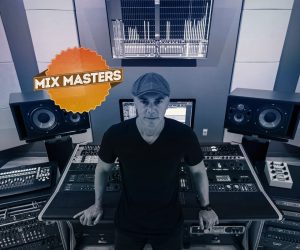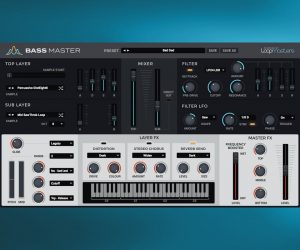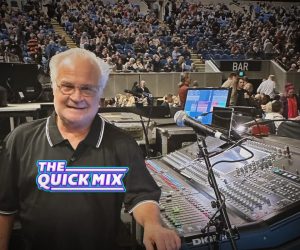
Mix Masters: Josh Gudwin
Designing Bieber’s Vocals with Josh Gudwin.

Artist: Justin Bieber
Album: Purpose
Song: Sorry
If there’s one thing America does right, it’s the comedy roast. Sure, it’s a completely see-through public relations stunt, but if you’re attempting to endear yourself to the public by inviting celebrities to dig at the base of a fellow tall poppy, at least everyone gets to laugh about it.
In the saga that is ‘Justin Bieber Growing Up’, Comedy Central’s roast was a hit. Beliebers should be old enough to handle a bit of satire by now but for any residual die-hards, armed with ‘I will kill you for Lulz’ on their Tweet speed dial, the roast was staged prep for them to get onboard with Biebs’ new grown-up image — and his new grown-up studio album, Purpose.
During the last two years the tabloids have eaten up any example of Biebs’ 101 on how not to grow up in public. He was the prima facie example of teenage pop idols ‘struggling’ with too much money and fame. Bieber turned 21 early in 2015 (finally, he can drink…), and as if to atone for his teenage indiscretions, there’s been a surprising new addition to his mien: contrition. There’s the song Sorry, of course, but also every time he’s appeared in the media lately, he’s taken the time to apologise and promise to ‘do better’ — the roast included. It’s as if Biebs, against all the odds, is actually trying to grow up. He even attributed his latest ‘meltdown’ to fans not taking him seriously while trying to scrub some muck off the stage. That’s right, Biebs was cleaning up after himself. Come on people, the guy lives on tour, so it was basically like interrupting his midweek cleaning regimen!
Purpose is his first album as a fully-fledged adult, and the singer decided to take full creative control. In short, Purpose was likely to be a career-defining album; a make-or-break proposition. To dramatise things further, the press whipped up a story about a sales race between Purpose and One Direction’s Made In The A.M., released in the same week.
The Bieber camp needn’t have worried. Purpose turned out to be an enormous commercial success, the singer’s most successful album yet in terms of chart positions worldwide. At times, his four major hit singles, Where Are Ü Now, What Do You Mean?, Sorry and Love Yourself were battling amongst themselves for the highest chart position, and Bieber now holds the title of most songs in the Billboard Hottest 100 at one time — 17, besting even The Beatles by three songs. Purpose won the pseudo-battle with One Direction hands-down.
FITTING PURPOSE
Purpose’s proliferation of songwriters and producers is impressive even by sprawling 21st century pop/R&B standards. Skrillex, Diplo, Ed Sheeran, Benny Blanco, Soundz, Mike Dean, Michael ‘Blood Pop’ Tucker, Jason ‘Poo Bear’ Boyd and Ian Kirkpatrick are among the dozens involved. Normally so many cooks is a warning sign of a scattered and disjointed album, but Purpose hangs together pretty well. Mainly because Bieber reduced his core team to the absolute minimum; one man, Josh Gudwin.
Gudwin was at Bieber’s side throughout the entire production process, earning him the unusual credit of Album Producer. The role involved album A&R, engineering almost all Bieber’s vocal sessions, mixing or co-mixing 12 of the deluxe album’s 18 songs, plus songwriting and production credits on a couple. Gudwin took care of the technical detail, while he and Bieber held the artistic focus together.
With such a large party of creatives, there was some serious pressure at the top. “The workload got so heavy towards the end that I had to bring in someone to help me with the final mixes,” recalled Gudwin. “My buddy Andrew Wuepper, who came up under Dave Pensado, came in for the last one to two weeks, and mixed seven songs with me. Even together we were doing 16 to 20 hour days! We’d go to and fro taking turns mixing a song for a few hours at a time. Mixing together was a treat, because normally our job is so self-obsessed.”
PLANTED IN LA
Gudwin has enjoyed a fairly meteoric career, studying at Florida’s Full Sail University during 2005-6, interning at Track Records Studio in LA, working with songwriter Esther Dean, and studying for two years with America’s number one vocal producer, Kuk Harrell. Gudwin has clocked up a set of very respectable credits, including T.I., Lionel Richie, T-Pain, Quincy Jones, Rihanna, Jennifer Lopez, Carly Rae Jepsen, Celine Dion and Pharrell Williams, but meeting Bieber in 2010 turned into a long relationship. Since then, Gudwin has worked with Bieber on Under The Mistletoe, Never Say Never: The Remixes, Believe, Believe Acoustic, Journals and Live At Madison Square Garden.
Gudwin’s credits on Purpose are the most wide-ranging in his work with Bieber so far. Talking from his in-the-box home studio in Los Angeles, Gudwin elaborated on the album’s gestation and the various roles he played in it: “Justin didn’t want outside people around who he doesn’t really know. I was fortunate to be in a position to take his vision and help him create a solid body of work. Over the years I’ve developed a sense of what music he likes and what type of songs he would want to write when he’s in a particular mood. Poo Bear also contributed greatly, and wrote many songs we knew Justin would really like. In all, Poo Bear and I brought the majority of the songs to the album.
“We began work on the album in late 2013 and worked full-time for more than a year. I kept an overview of the entire project, and managed all the files, contacts and exchanges with the writers and producers. We wrote and recorded in various studios in LA, Atlanta, New York and Toronto — even as far away as Greece — but it was mostly recorded at Record Plant in LA. Justin loves that studio, SSL 3 is one of the best sounding rooms in LA and was a bit like home base. Sessions can take place anywhere, but you need a place where you have consistency and the sound is always the same. Though I mixed some songs at Henson Studio D and Jungle City in NY, I mainly mixed at Record Plant. When I’m finalising a product for the best outcome I prefer to be in the same room for a couple of days.
“I did all Justin’s vocal recordings apart from a couple of songs when I was not available. Usually it’s just him and I. It’s a pretty easy process. Because Justin has been doing this for so long he has a very good knowledge of how to sing in the studio and the techniques that are used. Sometimes we will do a few takes and I will comp that later, sometimes I record him line by line. Basically my job is to capture him in the right way, and then I design his vocals and place them in the track.
“I use various microphones, like the Sony C800G, Telefunken TLM 251, Neumann U47, or U67. It depends on the sound we want. It’s pretty intuitive. We simply pick a mic, he starts singing and if it isn’t right, we try another one. We like to keep it moving. The mic pre is usually a Neve, and I like to use the Tube-Tech CL1B compressor on the way in, because it’s smooth and gives me the control I’m looking for. After that everything is in the box, apart from some hardware effects I like to use right at the end of the mix. All my sessions are done inside my laptop, so I can travel anywhere. I have an expansion chassis with an HDX card and two UAD cards, and can easily plug into any studio.”
I edit the vocals as I go, and groove them in real time. I like things to sound as good as possible when Justin walks out of the vocal booth






ROUGH EXPERIMENTATION
A lot of sound design went into Purpose, not dissimilar to another 2015 hit, The Weeknd’s Beauty Behind The Madness, which also was almost entirely created inside a laptop. That elaborate in-the-box sonic experimentation and polishing lets producers and artists chisel out their own sonic identity. Gudwin is no different. He explained how designed the sound of Bieber’s album was, including the singer’s vocals: “Often a major part of the sound design already comes from the producer. Skrillex is really good at creating his own sounds, and I then create vocal sound designs to go with that. But with other tracks I often go in heavy to create sounds. Once I get the songs from the producers, it’s pretty much just me. I record Justin’s vocals and I then try to get the vocal sound dialled in very quickly and start adding stuff during the mixing process. I use a lot of plug-ins! Justin gives me full creative freedom when it comes to mixing his vocals, but if he doesn’t agree, he’ll let me know.
“The vocal on every song is different, and requires different verbs and delays. I edit the vocals as I go, and groove them in real time. I like things to sound as good as possible when Justin walks out of the vocal booth, then I’ll dial in the finer details during the rough mix. I learned that from Kuk. When I worked with him he’d have the vocals recorded, edited and loaded into the track. Then it would take me two hours to do a rough mix. Kuk would say, ‘Just take 30 minutes, bro.’ So I learned to do a rough mix very quickly, and at the end of the day, that’s often the sound of the record. The rough mix is often more important than the final mix, because it sets the direction for the song. If the artist likes that direction, you don’t want to lose that by redoing sounds and so on. My final mixes are almost always refinements of the rough.”
MIXED EMOTIONS: SORRY
Sorry, the second single from Purpose, is a good example of Gudwin’s mix approach and the way the album came into being. The track was co-written by Bieber, Skrillex, Michael ‘Blood Pop’ Tucker, Justin Tranter and Julia Michaels, and produced by Skrillex and Blood Pop. According to Gudwin, the song was “cut at Roshambo Studios in Orange County, and Wu Wueper and I ended up mixing it together.
“Originally Skrillex was going to do his own mixes, with me just doing the vocal mixes and sending him the a cappellas. But he was on tour in India and didn’t have time to do anything. He sent me all his sessions in Ableton, which I loaded into Pro Tools for the mix. I did a rough mix first, which involved me digging in for 30 minutes to an hour until it felt good. I’m not paying a lot of attention to the technical aspects at this stage, I’m just putting on plug-ins quickly to get them to do what I want them to do. I do a lot of EQ-ing, mostly carving out frequencies and rarely boosting.
“I’ll start at any place in the track where I feel inspired to start. Basically I’m going in and start scrubbing, like washing a car. I go all the way down the session adding EQ, effects, and drops and filters — whatever is needed to create space and movement — then I’ll really dig into the vocal design. Once I can listen to the session without anything bothering me, that is the rough mix. I’ll put it in a folder and I’ll send it to Justin, and he’ll listen to it 1000 times. Sometimes the rough becomes the final mix. If we’re going with the rough, I’ll just do some final detail at the very end. For example, with What Do You Mean? we literally went with my rough mix. The beat and song are very straightforward, there is nothing crazy, and the rough had the feel, the vibe, and that was it. But with Sorry, Wu and I spent quite a bit of time working on the sounds and creating the final mix.”
The very end of the final mix of Sorry was tour-de-force, with Gudwin working on two sides of the US: “We started the final mix at Henson studio D and worked on it thru the night. I took a 6am flight to New York and went right to Jungle City and finished the mix that same day/night. Julia Michaels came to the studio to listen and she added some quiet background vocals in the hook. Once I got her parts in, the mix was done. The song was mastered the next day.”
















RESPONSES